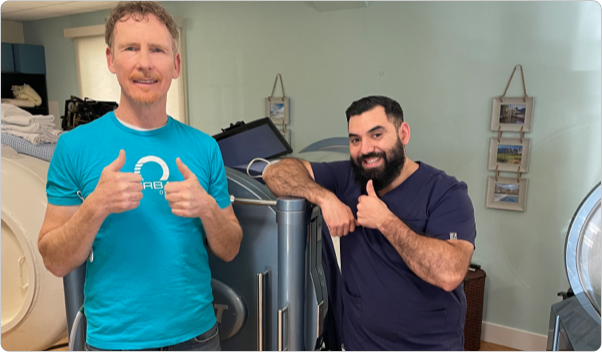Hyperbaric Oxygen Treats Central Retinal Artery Occlusion
If you or a loved-one is experiencing central retinal artery occlusion, go to the ER right away and require them to approve hyperbaric medicine. It’s your best chance for recovery. This condition can be caused by a blood clot, plaque build-up, or inflammation of the artery.
Central retinal artery occlusion (CRAO) happens when the main artery supplying blood to the eye's retina gets blocked. This leads to a sudden loss of vision in one eye, which sadly is often permanent. If you or someone you know experiences this, it's crucial to head to the emergency room right away. Getting hyperbaric oxygen treatment within 24 hours can help. Without enough oxygen and nutrients, the retina can suffer irreversible damage, causing vision loss.
Are you a Physician? View Physician version of this page

If you or a loved-one is experiencing central retinal artery occlusion, go to the ER right away and require them to approve hyperbaric medicine. It’s your best chance for recovery. This condition can be caused by a blood clot, plaque build-up, or inflammation of the artery.
Central retinal artery occlusion (CRAO) happens when the main artery supplying blood to the eye's retina gets blocked. This leads to a sudden loss of vision in one eye, which sadly is often permanent. If you or someone you know experiences this, it's crucial to head to the emergency room right away. Getting hyperbaric oxygen treatment within 24 hours can help. Without enough oxygen and nutrients, the retina can suffer irreversible damage, causing vision loss.
Are you a Physician? View Physician version of this page
How Hyperbarics Helps
Delivers oxygen directly to the retina and retinal artery, helping to heal the occlusion
Improves Blood Flow
Reduces Inflammation that can Cause Restriction Around your Retinal Arteries.
Promotes the Growth of New Blood Vessels
Hyperbaric oxygen therapy is your best chance for recovering your eyesight!
Hyperbaric oxygen therapy (HBOT) can boost oxygen delivery to the retina, helping it survive even when the artery is blocked. It does so by providing high levels of oxygen under pressure. This treatment can also stimulate the growth of new blood vessels, which aids in restoring blood flow and preventing further damage.
HBOT is safe and supported by numerous studies. It has been shown to improve vision and reduce the risk of complications like neovascular glaucoma. If you suspect CRAO, don't delay seeking medical help. Getting treatment quickly is essential for better outcomes.
Patients: Start with Hyperbarics
It's easy to start with Hyperbarics. Just follow these simple steps
1
Give Us A Call
Did a physician refer you? If so, they can download and fax us back a patient referral form. If not, our medical staff will discuss whether hyperbaric suits you.
2
We Talk With Your Insurance
Our medical staff contacts Medicare or private insurance to receive authorization and create a plan with you.
3
You Get On the Road to Recovery
We do a medical intake, explain everything you need to know, and get started on your hyperbaric oxygen anti-aging therapy sessions.

Related articles
Check out the following articles, which may also be relevant to your search
Still looking for answers?
We're here to help. Contact us today to learn more about how hyperbaric oxygen therapy can help you.
-
What is Hyperbaric Medicine?
Hyperbaric medicine, also called hyperbaric oxygen therapy or HBOT, is a medical treatment where a patient sits or lies in pressurized chamber and breathes 100% oxygen. In HBOT, oxygen dissolves into the blood, thus raising the oxygen concentration to very high levels.This increased oxygen is a primary building block for tissues, muscle, and bone repair. Among other benefits, it kicks off cell reproduction, heals injuries and infection more rapidly, and decreases inflammation.
-
Does HBOT kill cancer cells?
Current research indicates that hyperbaric oxygen does not kill cancer cells. However, there has been a small amount of research indicating that hyperbaric oxygen might reduce the size of certain tumors. Also, there has been a study on mice using hyperbaric oxygen, along with a ketogenic diet, to reduce tumors. Hyperbaric oxygen causes many different healing modalities to kick into gear. Could its effect on strengthening the immune system inhibit the growth of cancer cells? Nobody knows. There are numerous studies conclusively showing that hyperbaric oxygen does not encourage cancer cells or tumors to grow. Some patients claim the hyperbaric oxygen makes them feel a lot more comfortable and functional after chemotherapy and also during healing. Note that some chemotherapy drugs are not to be used with hyperbaric oxygen, as the chemotherapy drugs can be enhanced and thus become toxic. A good hyperbaric oxygen facility (such as Bay Area Hyperbarics) will always call the chemotherapy manufacturer to ensure that hyperbaric oxygen therapy will be helpful and not damaging to the patient.
-
What is the CPT code for HBOT?
The CPT code for HBOT is G0277.
-
Does Medicare cover HBOT?
Medicare covers Hyperbaric Oxygen Therapy for approved conditions, and many insurance companies also cover approved conditions. If your condition is not approved by your insurance, we can discuss our special rates. Give us a call at (408) 356–7438. We are happy to discuss your options with you.
-
Can HBOT help Neuropathy?
Hyperbaric treatments help heal neuropathy by regrowing small blood vessels and nerves that have died from disease, injuries from radiation and aging. Patients often experience numbness and or pain when they start treatment. Hyperbaric treatments most often bring back sensation and make, for example, walking easier and more enjoyable.
-
Why would a physician consider HBOT?
A physician would consider using hyperbaric chamber therapy under a variety of situations. Physicians most typically refer patients to hyperbarics when the patient is not healing with traditional medical interventions and hyperbaric chamber therapy is approved by Medicare for this condition. Some patients experience significant unresolved pain and unremitting disease states that the mechanisms of hyperbaric oxygen therapy in a hyperbaric chamber are known to affect, such as the down regulation of inflamatory genes. For an example, some patients have experienced severe, unremitting hives with itching, which did not improve with any specialists interventions. Some physicians will consider hyperbaric chamber therapy if the patient has no other good avenues for improving their failing health, and they know the hyperbaric chamber therapy is safe and will not harm the patient.
-
What is Hypebaric Oxygen Therapy?
Hyperbaric Oxygen Therapy (HBOT) Hyperbaric Oxygen Therapy (HB0T) is a medical treatment where you inhale 100% oxygen in a chamber with increased atmospheric pressure. HBOT injects 400x the oxygen into your tissues and bones and mobilizes stem cells. It regrows healthy tissues in the brain, blood vessels, skin and bones. It also reduces pain and swelling, and speeds recovery. It is simple, effective and painless.




